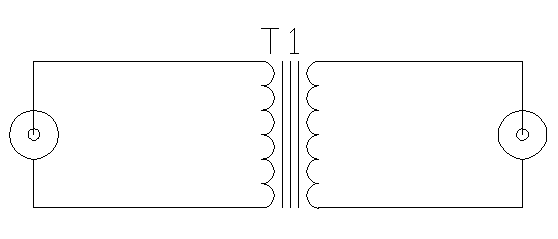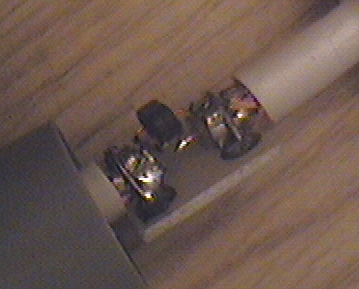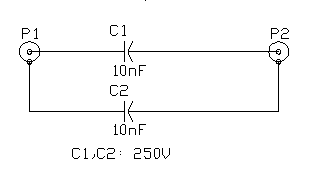Isolation between antenna network and TV/radio equipment
A ground loop in your AV system caused by antenna connection or TV cable is very common if you have your computer connected to the same system. This type of ground loop problem can be solved by using suitable isolation between your AV system and the antenna cable. The simplest way to get rid of the hum is to disconnect the antenna cable from the AV system. If you still want to watch cabe TV or listen to your radio an keep the system hum free then you have to install isolators to all those antenna cable connections your system has.
Build your own antenna isolation transformer
Best solution to antenna/cable caused ground loop is to add a 1:1 transformer in the antenna signal, floating the VCR with respect to the cable tv ground. This solved the hum, no need for a messing with the audio signal, and the tv image quality did not suffer (most tv's get an overdose of signal from the cable tv anyway).
You can simply make such a 1:1 transformer:
- Take two strands of insulated wire, length: 10-20 cm.
- Twist the two wires, about 1-2 twists per cm is enough.
- Next you need a small transformer core suitable for UHF frequencies. I used a donut shaped ferrite core. Try looking in an old TV or radio. Wrap the twisted wire a few turns around the core.
- One wire is the primary winding, the other the secondary (so it helps to color code the wires).
- Make the leads between the coaxial antenna plugs and the core as short as possible.
- You're making a transformer, i.e. if you have a red and a blue wire: connect the blue ends to one antenna plug, and the red wire to the other plug - not two colors on 1 plug.

I have seen other transformer circuits posted in the Usenet newsgroups. Kari Hautanen wrote an article to sfnet.harrastus.elektroniikka newsgroup about antenna isolator. The article says that you can built a suitable transformer using following method: Primary and secondary are three turns of 0.2 mm Cu-wire wrapped around small magenta colored toroidal ferrite core. Seems quite simple, but the article did not mention the exact core size. It mentions the source of the circuit to be a book Osmo A Wiio, Reijo Laine, Radioamat��rin k�sikirja, EU Harrastekirjat 1978, 1980, page 164. I have not been able to locate the book to check the circuit, but the circuit in one ready-made isolator had very similar circuit:

On the picture above you see the whole adapter and the picture below is close picture of the details inside the antenna isolator adapter.

It had three turns of thin wire in primary and secondary wrapped around small ferrite core. The wiring inside the isolator is very similar to the audio isolator circuit, the only difference is that now connectors are antenna connectors and the transformer is the one designed for antenna signals (described above). The thin wires between the transformer and the coaxial cable are kept minimum to avoid the adapter to pick up interference.
If you live in Finland, you can buy this type of isolation adapter from SUOMEN RADIOAMAT��RITARVIKE OY under name J A-A Junction h�iri�adapteri televisioon. It costs 43 mk (about 10 US dollars).
For more ideas how to fight against ground loop caused by cable TV connection, check the Fixing Cable-TV Hum in Audio Systems article by Jay Rose at http://www.dplay.com/tutorial/cablehum.html. Secrets of Home Theatre and High Fidelity web magazine reviewed an antenna wire ground loop isolator product UNHUMMER, so read the article if you are looking for an isolation device suitable for antenna network which is used in USA.
Simple two capacitor isolator
This circuit is a simple isolator for TV and Radio antenna connection. This circuit passes radio frequency signals nicely, but does not pass significantly 50 Hz signals, so the ground loop is eliminated. The circuit can be easily built into antenna connector or to a small box. I would recommend to use small metal box, where you connect one of the antenna connectors to the metal box and isolate other connector from box. Metal box allows mechanically strong construction and provides good shielding against radio interference. The capacitors in the circuit should be rated at least 250VAC (400V DC) to make sure that the adapter with stands situation when antenna network ot television/radio is floating at mains live potential.

There is one disadvantage of this the circuit breaks the continuous shielding of the antenna cable which makes you antenna cable pick up radio interference more easily (for example radio interference picked by ground loop itself). Usually this is no big problem, but if you notice severe interference then you might have to stop using this isolator. The beast place to put this isolator (to keep possibility of interference minimum) is just between TV receiver and antenna cable going to wall.
This capacitor isolator scheme might feel quite strange at the first sight, but it actually works and cuts the ground loop because it provides high impedance to low frequencies (50 or 60 Hz mains frequency) but has low impedance at the RF frequencies that are used at cable for TV channels. Capacitor isolator approach is an old trick used in TV industry. When the old TVs had their chassis at mains potential, they used this kind of approach to make sure that the dangerous voltage can get to the cable from the TV but the RF signal goes nicely to TV. Isolator used in one old TV had 330 pF 500 VAC capacitor which connects the center of the coaxial cable to tuner and the shield of the coaxial cable was connected to TV chassis through high voltage feedthrough capacitor (value unknown).
Transformer isolator using two baluns
There is an alternative approach to antenna isolation problem: use transformer as in audio lines. The problem is to how to make a good transformer for antenna signals. If the transformer causes impedance mismatches, this can cause signal reflections which disturb you and maybe your neighbors also.
One way to do it is to use readily available 75 ohm to 300 ohm
transformers (called "baluns" or "matching transformers") used when
connecting old televisions with 300 ohm antenna input to modern antenna
network with 75 ohm connectors. Those units are readily available from TV
shops. Be sure to buy models which have no galvanic connection
between 75 ohm input and 300 ohm output (so there is isolation
between input and output), because some models only do impedance
matching but galvanic no isolation (they are useless in this project).
The circuit is easy to build. Just take two of those 75 to 300 ohm
antenna transformers and connect their 300 ohm sides together. Now
you have antenna isolator you need.
____________ ____________
__| |------X------| |__
75 Ohm |__ | 300 Ohm | __| 75 Ohm
|____________|------X------|____________|
This circuit has been suggested by Paul Grohe ([email protected]), who
suggested that suitable transformers are available from Radio Shack
(Radio Shack cat. #'s 15-1140 and 15-1253 or MCM #33-050 and #33-010).
LiveDV magazine suggests using Radio Shack #15-1140 and #15-1523 antenna transformers wired together
in their "Soundings: Getting Wired" tutorial at 1996.
If you experience radio interference picked by this circuit, you
can try the following method to make shilding ogh the circuit better:
You can wrap the whole little assembly in aluminum foil and ground the
foil to the "cable" cable shield. But don't let it touch the other ground.
Aluminium Foil Shield
+--------------------------------+
| +--------+ +--------+
--Cable Co Coax-O----| Balun |======| Balun |-------- To TV
| +--------+ +--------+
+--------------------------------+
connect to shield of incoming coax
Commercial antenna signal isolators
- J A-A Junction h�iri�adapteri televisioon from SUOMEN RADIOAMAT��RITARVIKE OY
- Mondial MAGIC Box from Mondial Designs Limited
- Unhummer from Clearview Engineering
Tomi Engdahl <[email protected]>









